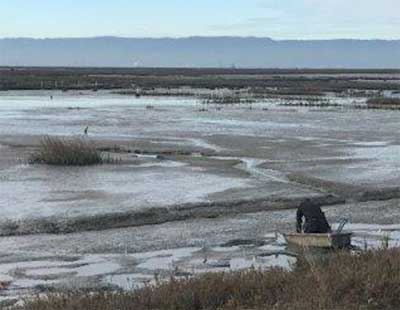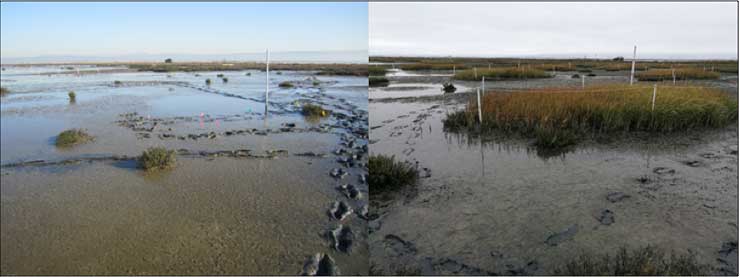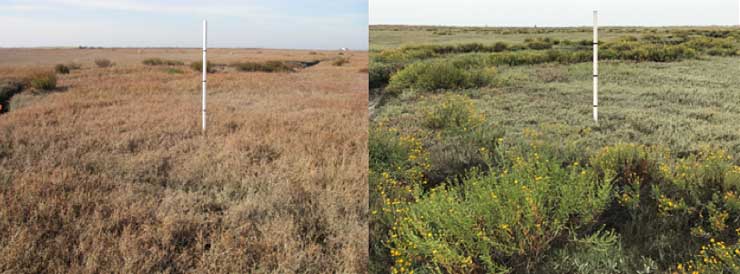San Francisco Estuary Invasive Spartina Project
July 2018

As a partner of the SF Bay Joint Venture you are likely familiar with Invasive Spartina (cordgrass) and know it has spread throughout our region, pushing into and out-competing it's native counterpart, Pacific cordgrass. There are multiple ramifications when a non-native species moves in and establishes where it doesn’t belong. In the case of Invasive Spartina some of these include: reduced biodiversity in our native marshes, changes to the nature of mudflats and negative impacts to foraging shorebirds.
Since 2005, the San Francisco Estuary Invasive Spartina Project (ISP) has been working to turn this situation around and has made some serious headway at reducing the infestation - from a high of 805 net acres bay-wide in 2005, down to 41 net acres as of 2017 monitoring! The work required is immense and relies on thoughtful coordination between more than 150 landowning partners and resource agencies, annual monitoring and treatment of more than 70,000 acres of tidal wetlands and mudflats, detailed planning and good old fashioned hard work out in the field.
As sites near eradication, it’s more important than ever to inform the ISP if you see any sightings of new cordgrass at developing restoration sites or elsewhere. Please report these to Project Manager Marilyn Latta. Your ongoing coordination is critical to achieving complete eradication and protecting the substantial investment in native tidal marsh restoration in SF Bay!
You will find more details on the project website - www.spartina.org

Meadows of native Spartina now cover substantial portions of Island Pond A21 (breached in 2006), and Ridgway's rails have been detected at the site for several years. The work of the Invasive Spartina Project protected this site during the early years of its maturation, allowing it to develop on a native trajectory without being thrown off course by hybrid Spartina invasion.
REGIONAL EFFORT
The San Francisco Estuary Invasive Spartina Project is a regional effort of the State Coastal Conservancy and the USFWS National Wildlife Refuge Complex that includes coordination among multiple natural resource agency management and technical staff, including the California Department of Fish and Wildlife, East Bay Regional Parks District, and dozens of additional local, state, and federal municipalities throughout the nine-county Bay Area. Olofson Environmental, Inc. is the primary technical consultant who works with the Conservancy to lead an interdisciplinary team of botanists, biologists, restoration ecologists, and local native plant nurseries that plan and implement the bay-wide eradication and restoration effort.
Project Management Team: The Conservancy, Refuge, CA Fish and Wildlife, East Bay Regional Park District, and the SFBJV have re-initiated a Project Management Team to continue to effectively plan for simultaneous protection of California Ridgway’s rails and continued work to get back to full treatment bay-wide to complete the eradication. The group is working on phased site planning, long term planning, joint fundraising, and other tasks. Please contact Matt Gerhart or Marilyn Latta for more information.
Treatment and Monitoring: There are 215 sub-areas that include over 70,000 acres bay-wide that receive monitoring and/or treatment. The ISP continued to conduct successful invasive Spartina monitoring and treatment in 2017, with the help and coordination of more than 100 landowning partners and field contractors. The amount of invasive Spartina decreased to 27 net acres baywide in 2016, but increased to 41 net acres in 2017. This increase is primarily the result of the expansion of invasive Spartina at the 11 sub-areas that have been restricted from full treatment by USFWS since 2012 due to concerns over California Ridgway’s rail. There was also a small increase at permitted sites due to heavy winter rains in winter 2016-17 after five years of extreme drought, which provided ideal growing conditions for both native and invasive tidal marsh species in San Francisco Bay. More than 150 of the sub-areas have less than 10 square meters of invasive Spartina remaining, 38 sub-areas had no invasive Spartina detected in 2017 (many for more than three years), and we are making substantial progress despite the restricted site issue. The Conservancy and USFWS made progress on the permitting for these previously restricted sites in 2017, when the USFWS Bay-Delta office transferred the lead role on the Section 7 Endangered Species consultation to the Don Edwards San Francisco Bay National Wildlife Refuge, the federal lead on the project. In August 2017, the Refuge issued a three-year permit for all sub-areas that have been receiving annual treatment . The Conservancy and Refuge are working closely with the affected landowning partners and key stakeholders to thoughtfully plan for future phased treatment at the 11 sub-areas currently restricted from full treatment.
Restoration Enhancements: In the past seven winters, the project has installed more than 450,000 seedlings of primarily native Pacific cordgrass and marsh gumplant at more than 40+ sites in an ambitious program to rapidly enhance native habitat for Ridgway’s rail and other species. The most recent planting efforts, in winter 2017-18, concluded in early April with the successful planting of over 25,000 seedlings. The annual monitoring of plantings will occur in Fall 2018. A total of 62 high tide refuge islands have been installed since 2012, and are providing critical habitat for Ridgway’s rail at Dumbarton Marsh, Corte Madera Ecological Reserve, Palo Alto Baylands, and many other sites. The Coastal Conservancy is also integrating native cordgrass and estuarine-terrestrial transition zone habitat enhancement into an expanded living shorelines approach at a new site, Giant Marsh, located within the EBRPD’s Point Pinole Regional Shoreline. See www.spartina.org for the ISP 5-year restoration plan and habitat enhancement installation and monitoring reports.
2018 California Ridgway’s Rail Monitoring: Rail monitoring occurred from January 15 - April 15, 2018 and populations seem to be on the upswing with call count surveys showing an increase over previous years. The ISP works closely with the other rail monitoring partners (Refuge, Pt Blue Conservation Science, EBRPD, Avocet Research Associates) to coordinate site planning and data sharing on call count monitoring, and all partners have transitioned to a new North American protocol after two years of piloting it at the sites. There are rail increases baywide in 2018, including at multiple large-scale restoration projects that are developing vegetation structure, such as the Island Ponds, Sonoma Baylands, and Tubbs Island. In 2017, the ISP met the “80 rail goal”, showing an increase of more than 80 rails over three consecutive years compared to a 2010 list of baseline sites, which subsequently allowed for USFWS consultation regarding full treatment to resume. It’s important to note that a substantial portion of the rail increase is in high-quality native marsh (including sites that can be treated for invasive Spartina), but about half of the increase is in the currently restricted sites.
Restricted treatment sites: Treatment has been prohibited from 2012-2017 at 11 sub-areas, and the Conservancy and Refuge are now working to develop conservative, phased treatment and revegetation plans to initiate eradication activity again at these sites now that the 80-rail goal has been met. This process includes all affected landowners and other key agency staff and stakeholders advising the process. The sites include: Citation Marsh North (20d.1), North Marsh (20f), Bunker Marsh (20g), San Lorenzo Creek Marsh North (20h.1), Cogswell Quadrant B (20n), and Cogswell Quadrant C (20o) in the Hayward Region (Region 6); Arrowhead Marsh East (17c.2), MLK Regional Shoreline-Damon Marsh (17d.4), MLK New Marsh (17h), Fan Marsh (17j) in San Leandro Bay (Region 7); at one sub-area, B2 North Quadrant East (02c.1b) in the San Mateo Region (Region 3), aerial application of herbicide for suppression of hybrid S. alterniflora seed production is the only treatment permitted.
Outreach and Website: In 2018, the project plans to perform a website upgrade and develop new FAQ resources and information on the current status of the project. The ISP is at a critical stage, and is also a critical step in the baywide restoration of tidal wetlands in the San Francisco Estuary. Early and regular communications and information sharing with landowners and project managers is critical as we approach eradication and target field based work with the most efficient approaches possible.
For more information contact Marilyn Latta, 510-286-4157.

Photos taken before and two years after planting of native S. foliosa at a recently restored marsh. PVC and rope caging is visible around successful plantings that have grown and expanded for two growing seasons. The caging was removed after this photo was taken.

Photos taken before and five years after planting of marsh gumplant at a restored marsh. The marsh gumplant visible in the left photo is the result of an ISP focused pilot effort to introduce marsh gumplant to this site and these plants informed where the current intensive planting efforts are focused.